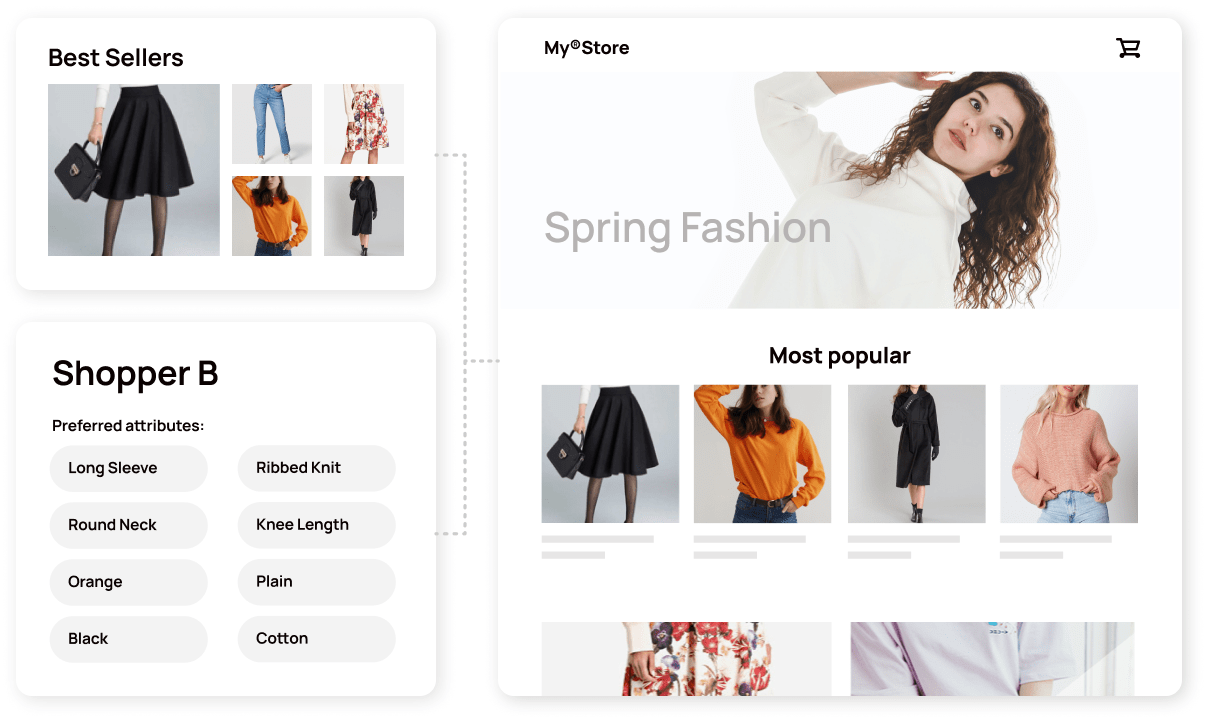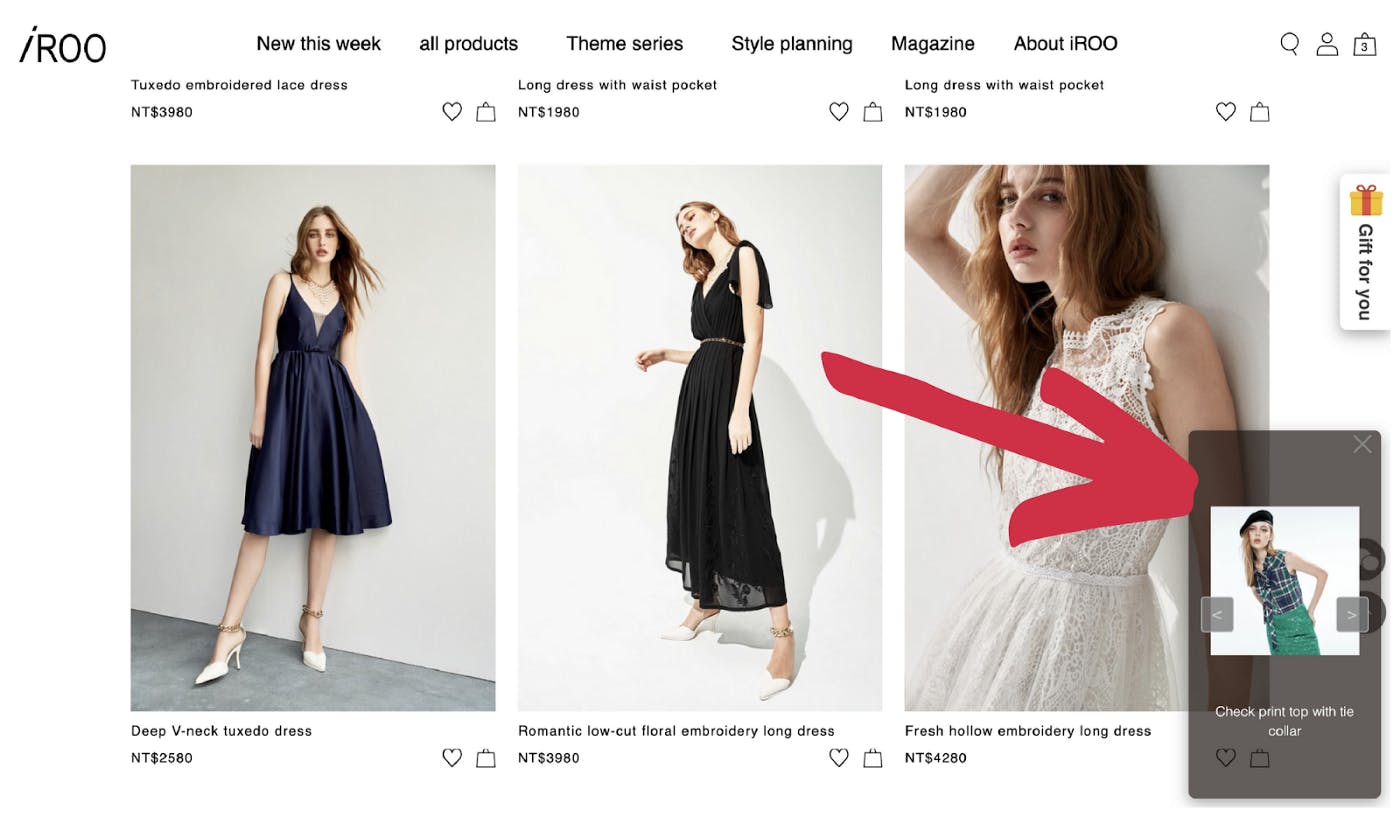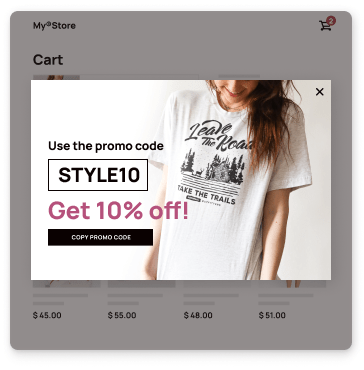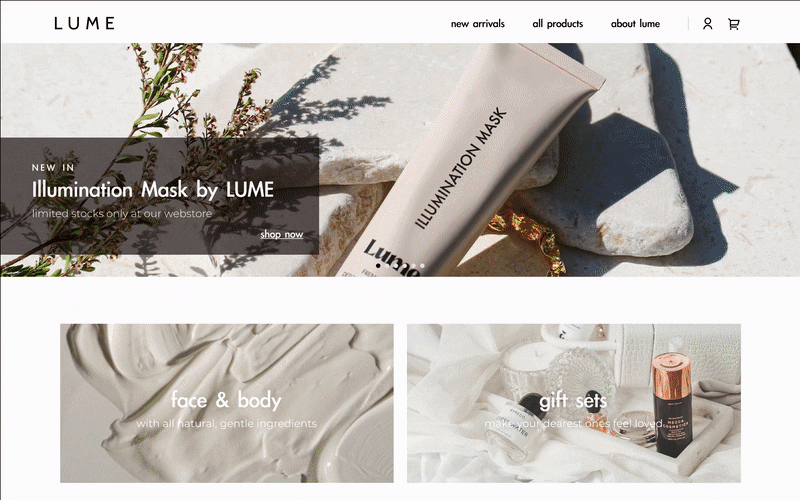The growing accessibility of website personalization
Everybody knows that personalization works and that consumers expect it now so more and more SaaS providers are providing new solutions for ecommerce merchants of all sizes.
Now, even medium-sized websites are personalized. There are plenty of subscription-based personalization software services that are actually more advanced than Amazon.
Baseline features and benefits for ecommerce teams include:
- Fast onboarding and ROI without coding or complicated integrations
- Easy-to-use dashboard control that eliminates technical know-how bottlenecks
- Cross-functional usability that empowers a variety of marketing roles
- Automated shopper preference analytics that provide first-party customer data insights
- Secure onsite control of customer data that keeps your site GDPR compliant
Long gone are the days when personalization simply meant putting your customer’s name in the subject line of your email outreach. Now the customer journey is personalized from start to finish and ecommerce marketing teams are looking for the latest solutions.
What’s new for website personalization in 2023?
Nowadays top SaaS providers are more focused on the merchants’ customer experience than ever before and predictive personalized marketing tools powered by AI visual recognition and NLP, which were once only in the hands of the biggest players, are now becoming more specialized for SMBs.
- For marketing teams in the image-heavy industries of apparel, cosmetics and accessories, steps are taken immediately during onboarding to optimize the personalization tools to the niche.

- And while big companies like Nike can set up their own advanced recommendation systems, options for meeting SMB business goals like increasing sales and growing a user base are now widely available and quite affordable.

- The latest personalization solutions are highly customizable so they can provide onsite recommenders that can adjust to match the look and feel of any website.
- Automated consumer preference analysis tools that collect CRM data and valuable consumer insights from first-party data about product preferences for sales and marketing.
This is how the experience begins with a modern personalization solution. Merchants of all sizes can now use these powerful tools to create unique shopping experiences on their ecommerce sites for their online shoppers — tools once reserved exclusively for the biggest players in ecommerce.
What do modern personalized experiences on websites look like?
On the front end, personalized recommendations from SaaS providers are usually presented in a recommender box and can appear on landing pages, category pages and especially on product pages and checkout pages (where shoppers are most likely to add to cart).
On the backend, automatically created visitor profiles feature individual data on product preferences.

The recommendation can appear like the wider in-page carousel above, or the more discrete one below:

Besides that, many sites use pop-ups on their homepages or special landing pages, offering up a discount for first time visitors to improve the page's click through rate.

Websites that use these pop-ups nowadays can get Hesitant Customer Detection to assess browsing behaviors (based on time on page, exit-intent, scroll pattern, clicks, etc.), and time the pop-up just right. So when a shopper begins comparison shopping or is about to abandon a cart, your site will know and engage before the bounce occurs.
Great personalization focuses on ecommerce fundamentals
Marketers who invest in advanced personalization solutions see immediate and lasting improvements for the three “Cs” of ecommerce:

Consumer insights
Knowing exactly what online shoppers want is becoming and smart brands do whatever they have to do do get to know their customers well. Instead of telling consumers what they should like, brands are now using to listen to consumers and find out what they actually like. Then, when shoppers arrive onsite, personalized product recommendations and discounts can be made that accurately match their preferences.
Actionable preference analytics
Gaining a deeper understanding of customer buying habits and product preferences has traditionally been a competitive advantage for bigger companies with the resources to perform market research.
But now even medium sized businesses can understand what customers want thanks to AI-driven solutions that provide automated data collection with specialized analysis parameters for certain industries, especially fashion and beauty.
The consumer insights gleaned by these tools help to get daily jobs done for marketing teams responsible for website customer experience optimization and even for product designers.
Discover audiences, plan experiences
Groups of consumers with common preferences can be targeted as a single audience and today’s personalization tools give you the ability to discover the attributes that shoppers share.
This is the first step in planning a personalized online experience. Knowing the attributes that appeal best to certain groups provides the content for the messages you want to send.
Conversion optimization
is all about getting shoppers who visit your website to take a desired action, ultimately, to buy something. For fashion and apparel, an August 2021 study found that average sales conversion rates rose from 0.48% to 1.71% an increase of only 0.23%!
Now pause for a moment and compare that small increase to that L’Oréal Luxe brand, Shu Uemura, experienced last year when they adopted personalized recommendations with image-based AI. This is the overwhelming power of personalization.
Personalized recommendation boxes
Shu Uemura used to create unique customer experiences at important moments during the customer journey.

A preference profile and a personalized discount pop-up on the Shu Uemura site.
For example, when a shopper arrives on your landing page a personalized recommender box or discount pop-up can be set to engage them and then each time they return the personalized recommendations will get more and more accurate.
Engaging shoppers with predictive personalization provides the one-to-one attention that people are much more likely to respond to and it makes a real difference when deciding to purchase or not.
Cross selling to increase average order value and ROAS
When the right kind of personalized recommendations are placed at the right point of the customer journey, shoppers respond and the chances of a cross-sell even more. Many sites opt to add a recommendation box or a pop-up on the product details page, just as the shopper is considering clicking the Add To Cart button. At this stage the shopper just needs a little emotional nudge to convert and recommending an item from the shopper’s preference profile can deliver a feeling of being empathized with.
Another way to do it is to offer a discount on something that the shopper intends to buy. Again, a well-developed preference profile on the backend makes this possible. Presenting a good deal on another item that a shopper truly wants increases your chance of converting.
Automating this kind of engagement during the final part of the online customer journey is like the merchandising you can find in a grocery store store, where tempting treats are presented near the cashier; or even in a clothing shop, where socks and underwear are near the checkout counter.
ROAS up, customer acquisition cost down
Advertising can help grow traffic, but in the fashion industry converting it requires special effort at the point of sale. For apparel and beauty shoppers, including personalization all along the customer journey makes a big difference. On average, websites that deliver this experience have tripled their conversion rates and doubled order value.
The specialized website personalization tools from Rosetta AI are helping fashion ecommerce sites raise click-through rates, average order value and CVR, thus achieving higher return on ad spend and lower cost per customer.
Customer retention
The lowest costing customers are ones that return to shop again. So it’s important to be continually to keep shoppers engaged and coming back for more.
Onsite customer retention strategies
First impressions count. If you welcome new visitors with personalized campaigns they will remember the experience.
And as the customer’s journey progresses the idea is to continually engage and reduce friction.
However, there will be problems that are out of your control and some shoppers will inevitably bounce. Some will be comparison shopping and they will abandon their carts at the last moment.
This is a normal part of ecommerce so it’s best to have a strategy in place to deal with these situations when they occur. Providing a last chance incentive just as customers are about to bounce has been shown to be very effective when it’s personalized.
Personalized offering a discount or a recommendation when a hesitant shopper is just about to leave your site often reverses their intention.

So how does your site know if a shopper is about to leave? Machine learning monitors hesitant customer behavior. When indicative patterns of clicking and scrolling are detected, a pop-up is automatically deployed.
Conclusion
Personalization has come a long way in a short time. In recent years it has become especially optimized for particular industries like apparel and beauty.
The advantages that once were in the sole hands of big brands have become available to merchants of all sizes and now small and medium sized businesses can use these new tools to scale business like never before.
But with the explosion of new personalization platforms offered in the ecommerce website fashion space, marketing team leaders and brand operators must choose wisely to find services that are truly in touch with what shoppers are seeing in thing products they desire.















